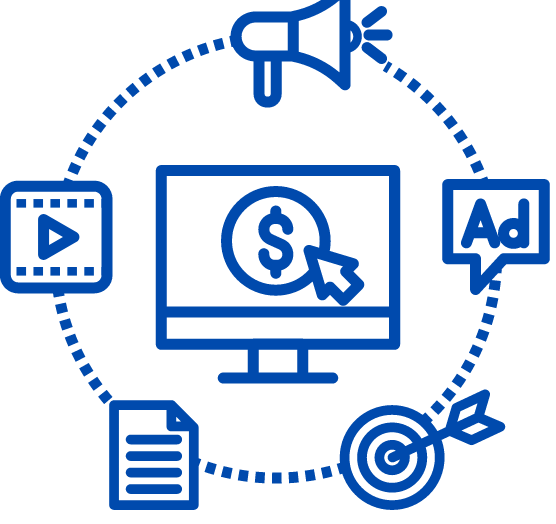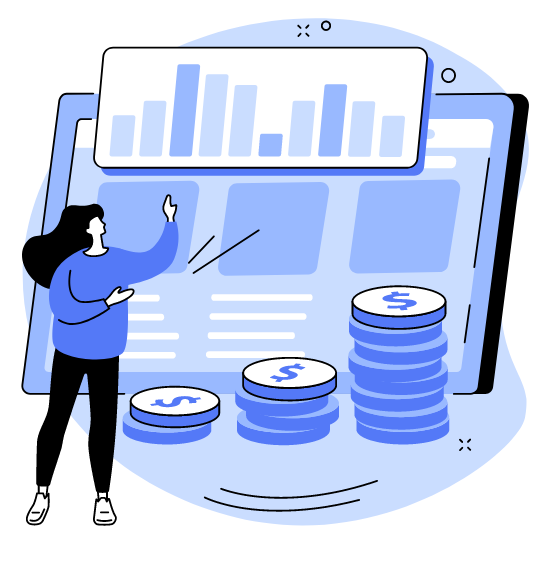The Ultimate Guide to PPC Ads:
"The Ultimate Guide to PPC Ads" is a comprehensive resource designed to demystify the world of Pay-Per-Click (PPC) advertising.
Whether you're a digital marketing novice looking to understand the basics or a seasoned professional seeking advanced strategies, this guide is your go-to reference.
Dive into the intricacies of PPC, discover how to create effective campaigns, optimize your ad spend, and achieve unparalleled results in the competitive landscape of online advertising.
With actionable tips, expert insights, and real-world examples, this guide equips you with the knowledge and tools to harness the power of PPC and drive targeted traffic to your website while maximizing your return on investment.
Get ready to master the art of PPC advertising with this ultimate guide at your side.

How to Create Effective Pay-Per-Click Advertising Campaigns?
Understanding the Power of PPC Ads
The power of PPC (Pay-Per-Click) ads lies in their ability to deliver highly targeted and measurable advertising results. Here are some key aspects that illustrate the power of PPC ads:
1. **Targeted Reach:** PPC platforms, such as Google Ads and Facebook Ads, allow advertisers to define their target audience based on various criteria like demographics, location, interests, and online behavior. This precision ensures your ads reach the right people at the right time.
2. **Immediate Visibility:** PPC ads provide instant visibility for your business. As soon as your campaign is live, your ads can appear on search engine results pages or social media feeds, driving immediate traffic to your website or landing page.
3. **Cost Control:** You have complete control over your advertising budget with PPC. You set the maximum bid you're willing to pay for a click or impression, ensuring that you only pay when someone interacts with your ad. This cost-per-click (CPC) model allows for efficient budget allocation.
4. **Measurable Results:** PPC provides robust tracking and reporting tools. You can measure every aspect of your campaign, from clicks and conversions to ROI. This data allows for data-driven decision-making and ongoing optimization for better performance.
5. **Adaptability:** PPC campaigns can be quickly adjusted and optimized based on real-time data. If certain keywords or ad creatives aren't performing well, you can make changes to improve results. This agility is especially valuable in responding to market trends and competition.
6. **Brand Exposure:** Even if users don't click on your ads, they still see your brand name and message, increasing brand exposure and recognition.
7. **Geo-Targeting:** You can target specific geographic regions, ensuring that your ads are seen by potential customers in your target market.
8. **Remarketing:** PPC platforms allow you to target users who have previously visited your website, keeping your brand top-of-mind and encouraging return visits or conversions.
9. **Ad Extensions:** PPC ads can include extensions like site links, callouts, and structured snippets, providing additional information and enhancing ad visibility.
10. **Competitive Advantage:** When managed effectively, PPC can give you a competitive edge. You can outbid competitors for top ad positions or strategically target their audience.
11. **Customization:** You can create tailored ad campaigns for different objectives, such as driving website traffic, generating leads, or promoting specific products or services.
12. **Ad Testing:** PPC platforms allow you to run A/B tests to determine which ad variations perform best, enabling continuous improvement.
In summary, the power of PPC ads lies in their precision, immediacy, and flexibility. They provide a cost-effective way to reach your target audience, generate leads, and drive conversions while offering robust data to refine your marketing strategies for optimal results.

1. The Basics of PPC Advertising
What are PPC ads?
PPC ads, or Pay-Per-Click ads, are a form of online advertising where advertisers pay a fee each time one of their ads is clicked by a user. These ads are primarily used to drive traffic to a website or landing page, and they are a key component of digital marketing strategies.
PPC advertising can be highly effective when managed strategically. It offers precise targeting, measurable results, and the ability to control ad spend. It's a versatile tool for businesses looking to increase website traffic, generate leads, boost sales, or promote specific products or services online.
How do PPC ads work?
PPC ads, or Pay-Per-Click ads, are a form of online advertising where advertisers pay a fee each time one of their ads is clicked by a user. These ads are primarily used to drive traffic to a website or landing page, and they are a key component of digital marketing strategies. Here's how PPC ads work and what they entail:
1. **Auction-Based System:** PPC ads typically operate on an auction-based system, where advertisers bid for ad placement on search engines like Google, or on social media platforms like Facebook, Instagram, and Twitter. Advertisers specify the maximum amount they are willing to pay for a click on their ad.
2. **Keyword Targeting:** Advertisers select specific keywords or key phrases related to their products, services, or content. When users search for these keywords on a search engine, or when their online behavior matches the criteria set by the advertiser on social media, the ad may be displayed to them.
3. **Ad Creation:** Advertisers create text-based or display ads that are relevant to the chosen keywords. These ads typically consist of a headline, a description, and a link to a landing page. They are designed to attract clicks from users who are likely to be interested in what the advertiser offers.
4. **Ad Placement:** PPC ads can appear in various places, depending on the platform. On search engines, they often appear at the top of search results or alongside organic search results. On social media, they can appear in users' feeds or as sponsored content.
5. **Ad Ranking:** Ad position is determined by a combination of the bid amount, ad quality, and other factors set by the platform's algorithm. Advertisers with higher bids and more relevant ads are more likely to secure top ad positions.
6. **Cost Per Click (CPC):** Advertisers are charged only when a user clicks on their ad. The cost of each click varies depending on factors like competition for keywords and ad quality. This payment model ensures that advertisers pay only for actual user engagement.
7. **Tracking and Optimization:** PPC platforms provide tools for tracking ad performance. Advertisers can monitor clicks, impressions, click-through rates (CTR), and conversions. Based on this data, they can adjust their campaigns to improve ROI and achieve their advertising goals.
8. **Ad Extensions:** Many PPC platforms offer ad extensions that allow advertisers to include additional information, such as site links, phone numbers, and location information, in their ads, enhancing their visibility and relevance.
PPC advertising can be highly effective when managed strategically. It offers precise targeting, measurable results, and the ability to control ad spend. It's a versatile tool for businesses looking to increase website traffic, generate leads, boost sales, or promote specific products or services online.
The Benefits of Using Microsoft Responsive Search Ads:
1. Enhanced Ad Performance with Dynamic Headlines and Descriptions
2. Improved Ad Personalization for Targeted Audiences
3. Increased Click-Through Rates through Automated Optimization
4. Higher Conversion Rates with AI-driven Ad Delivery
5. AI-powered ad delivery system, machine learning algorithms for conversion optimization
Key terms and concepts in PPC advertising (CPC, CTR, Quality Score)

2. Setting Up Your First PPC Campaign
Selecting the right platform for your campaign (Google Ads, Bing Ads)
Campaign goals and objectives
Determining your target audience and keywords
Budgeting and bidding strategies
Create compelling ad copy and design effective landing pages
3. Optimizing Your PPC Campaign for Success
Analyzing campaign performance metrics (CTR, conversion rate)
A/B testing ad variations to improve performance
Bid management techniques
Negative keywords
Leveraging remarketing strategies
4. Common Mistakes to Avoid in PPC Advertising
Overbidding on keywords
Poorly targeted campaigns
Ineffective ad copy or landing pages
Lack of tracking and measurement
Ignoring competitor analysis
The Different Types of Ad Extensions Available in Microsoft Advertising
1. Sitelink Extensions: Enhance Your Ads with Additional Links
2. Call Extensions: Drive Phone Calls Directly from Your Ads
3. Location Extensions: Boost Foot Traffic to Your Physical Stores or Offices
4. Review Extensions: Build Trust and Credibility with Positive Reviews
5. Callout Extensions: Highlight Key Selling Points or Offers in Your Ads
Click here to download FREE Microsoft PPC Ads Guide


